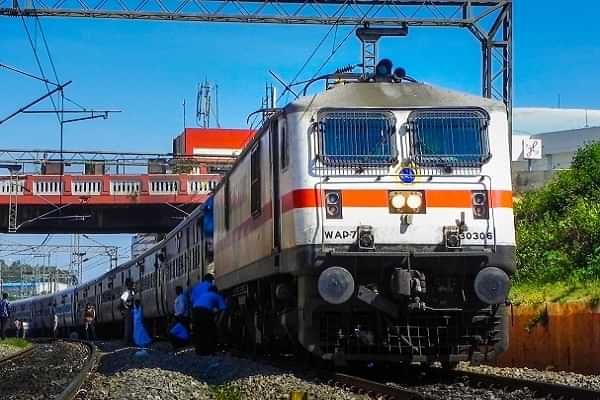Ideas
How Indian Railways Is Leading The Way In Reducing The Nation's Carbon Footprint
TV Mohandas Pai and Nisha Holla
Jun 26, 2021, 11:24 AM | Updated 11:25 AM IST
Save & read from anywhere!
Bookmark stories for easy access on any device or the Swarajya app.


Most countries across the planet are now concerned about climate change as the impact of unprecedented carbonisation of the atmosphere becomes more evident.
Global temperatures are expected to rise by 1-1.5oC with the existing use of fossil fuels. Both the Arctic and Antarctic ice caps are melting rapidly, with regular reports of breakage.
Several reports warn of an increase in sea levels of up to 6 feet by 2100, potentially endangering many urban conglomerates and cities at seashores. The rate of severe tropical cyclones, hurricanes, forest fires, and droughts is increasing, as is the abnormal movement of animal and sea life towards the poles as oceans get warmer.
The COP21 (Conference of the Parties) in 2015 in Paris pledged to achieve zero net emissions of greenhouse gas emissions by 2050 to curb rising temperatures.
Another global conference is planned for 2026 to take stock and deepen the pledge commitments. The US has rejoined COP21 and China has committed to becoming carbon neutral before 2060.
India, under Prime Minister Modi's leadership, has committed to increasing the share of alternate energy production capacity to 40 per cent by 2022 and increasing forest cover to 33 per cent.
As of now, India is the only country on track to meet its commitment. Nearly 10 per cent of overall energy consumption is met by alternate energy, and a 175,000MW install base of alternate energy - primarily solar and wind - is on track to be completed by 2022.
The Indian Railways (IR) - the fourth-longest railway system in the world - is a mega-consumer of fossil fuel in India, in the form of diesel. For India to significantly reduce its carbon footprint, it is imperative for IR to rework their incoming energy sources and consumption efficiency.
In this regard, IR has undertaken a series of steps to become carbon neutral and uphold its commitment to the nation's energy mandate and is doing remarkably well at that.
IR has planned to move away from diesel as a primary fuel source to electric traction. During the 2014-21 period, 24,000 route KM(RKM) has been electrified as against 4,337RKM during the 2007-14 period.
It is on track to complete 100% electrification of BG by December 2023; 71 per cent is complete with 18,800RKM to go. At 100 per cent electrification, the savings is estimated at INR 14,500 crore annually.
IR's electrification program will significantly reduce operations costs, enable heavier train loads, allow longer and faster journeys, and reduce overall energy consumption.
Further, IR is exploring and installing innovative technologies and management techniques to further reduce its carbon footprint. Switching to direct supply from overhead power equipment to carriages and using energy-efficient equipment for AC carriages and maintaining temperatures between 24-26oC will conserve energy.
Electric engines are being re-engineered and manufactured in India to use higher horsepower, particularly 12,000 HP, and containers are being switched to double stack - when these come into use, trains can average 50+ kmph speeds as opposed to the current 25 kmph, there will be lesser hold-ups through better signalling, and longer trains reduce costs with faster turnaround of cargo.
The boost in manufacturing of electric locomotives, from 264 in 2013-14 to an estimated 905 in 2021-22 is enabling this shift from diesel rapidly.
IR is also focused on measures to save water with the use of Bio Toilets that use vacuum technology, mechanical washing of trains, mechanised cleaning of carriages, faster pumping of water for use in trains, and rainwater harvesting across its extensive property base. These initiatives are already leading to huge savings in water consumption.
Switching from diesel to electric locomotives will not produce the desired carbon footprint reduction unless the electricity to power the engines comes from clean sources.
Currently, 70 per cent of India’s electric energy comes from thermal plants; this is slated to reduce to 50 per cent by 2030. IR has already installed 114MW worth of solar on the rooftops of 1000+ stations and 400+ service buildings.
Another 25,000MW of land-based solar power is being planned with storage facilities as well. IR is also planning to buy 150MW green power from the market to augment its production.
Further, LED bulbs have been installed across all stations, buildings and railway installations for efficiency.
IR's initiatives to make the railways more energy efficient will have a massive impact on the Indian economy with faster transport of goods at lower costs.
IR can target a 45 per cent share of goods traffic in 2030 compared to the current 27 per cent; reducing road carriage and thereby reducing the use of fossil fuel, the need for crude imports, and India's overall carbon footprint.
India’s success in reducing its carbon footprint and meeting its COP21 commitments largely depends on how massive consumers of energy transform themselves. It is heartening to note how the Indian Railways is leading the way in this transformative period.
TV Mohandas Pai is Chairman, 3one4 Capital, and Nisha Holla is Research Fellow, 3one4 Capital



.jpg?w=330&q=75&compress=true&format=auto)

